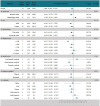Prevalence, risk factors, and outcomes of dysphagia after stroke: a systematic review and meta-analysis
- PMID: 39087010
- PMCID: PMC11288910
- DOI: 10.3389/fneur.2024.1403610
Prevalence, risk factors, and outcomes of dysphagia after stroke: a systematic review and meta-analysis
Abstract
Background: Dysphagia is a common complication after stroke, which not only brings adverse outcomes but also greatly affects the quality of life of patients. At present, there is no systematic review or meta-analysis to comprehensively evaluate the epidemiological characteristics of post-stroke dysphagia (PSD). A systematic review of the prevalence, risk factors, and prognosis of PSD is essential.
Methods: Through 31 December 2022, a comprehensive literature search was performed for observational studies related to PSD. Five databases were retrieved. Random-effects models were used to estimate the pooled prevalence, odds ratio (OR), and 95% CIs.
Results: A total of 34 studies were included, and the results showed that the overall prevalence of PSD was 46.6% (95% CI, 0.405-0.528). The prevalence of dysphagia in ischemic stroke and hemorrhagic stroke was 43.6% (95% CI 0.370-0.501) and 58.8% (95% CI 0.519-0.654), respectively. The prevalence of PSD in Africa was 49.4% (95% CI, 0.196-0.792), in Asia was 40.1% (95% CI, 0.348-0.454), in Europe was 45.8% (95% CI, 0.327-0.590), in North America was 44.3% (95% CI, 0.370-0.517), in South America was 57.5% (95% CI, 0.441-0.708), and in Oceania was 64.1% (95%CI, 0.558, 0.724). In risk factor analysis, hypertension, previous stroke, and atrial fibrillation were significantly associated with the occurrence of PSD, pooled OR = 1.179 [(95% CI, 1.002-1.386), p < 0.05], pooled OR = 1.514 [(95% CI, 1.204-1.905), p < 0.001], and pooled OR = 1.980 [(95% CI, 1.580-2.481), p < 0.001]. In outcome studies, the prevalence of aphasia and dysarthria in PSD was 35.6% (95% CI, 0.213-0.499) and 54.5% (95% CI, 0.293-0.798), respectively. The prevalence of respiratory tract infection was 27.1% (95%CI, -0.038-0.579), and the prevalence of pneumonitis was 32.1% (95% CI, 0.224-0.418). Persistence of dysphagia at discharge and at 1 month was 74.5% (95% CI, 0.621-0.869) and 50.9% (95% CI, 0.142-0.876), respectively. Mortality rates for PSD patients during admission and discharge at 1 month, 3 months, and 1 year were 11.8% (95% CI, 0.083-0.152), 26.5% (95% CI, 0.170-0.359), 25.7% (95% CI, 0.19-0.324), and 31.3% (95% CI, 0.256-0.369), respectively.
Conclusion: This study found that the overall prevalence of PSD was 46.6%. Prevalence is most influenced by the diagnosis method. Hypertension, history of stroke, atrial fibrillation, patient age, and stroke severity were risk factors significantly associated with PSD. The prevalence of aphasia, dysarthria, respiratory tract infection, and pneumonitis in PSD patients is 2-4 times that of patients without PSD.Systematic review registration: www.crd.york.ac.uk/PROSPERO, PROSPERO, CRD42021252967.
Keywords: dysphagia; meta-analysis; post-stroke dysphagia; prevalence; stroke; systematic review.
Copyright © 2024 Song, Wu, Wang, Pang and Zhu.
Conflict of interest statement
The authors declare that the research was conducted in the absence of any commercial or financial relationships that could be construed as a potential conflict of interest.
Figures
References
-
- Lozano R, Naghavi M, Foreman K, Lim S, Shibuya K, Aboyans V, et al. . Global and regional mortality from 235 causes of death for 20 age groups in 1990 and 2010: a systematic analysis for the global burden of disease study 2010. Lancet. (2012) 380:2095–128. doi: 10.1016/S0140-6736(12)61728-0, PMID: - DOI - PMC - PubMed
Publication types
LinkOut - more resources
Full Text Sources






